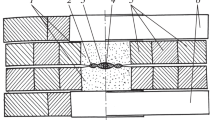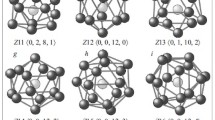Abstract
Based on the earlier reported conceptions about the possibility to control the structure of liquid alloys by varying the heating temperature, we think that the use of optimized heat treatment of staring melts shows promise for stabilizing the properties of advanced liquid-metal coolants of nuclear reactors. This idea is confirmed by the results of studying the binary lead–bismuth, lead–tin, and gallium–indium liquid eutectics. Evidence about their metastable microheterogeneity, which can be retained in wide temperature ranges for a long time after melting a coolant, is obtained experimentally. Changing the preparation method of the melt is shown to weakly affect the degree of its heterogeneity and the temperature of transition into a homogeneous state. The main ways of eliminating the effect of the above microheterogeneity on the safe operation of a reactor are determined. The possibility to improve the quality of amorphous ribbons prepared by melt quenching and bulk amorphous alloys as a result of application of optimized temperature conditions of their melting is discussed. The effect of heat treatment of a starting melt on the structure and properties of amorphous samples prepared by traditional melt spinning is shown by examples of a number of systems. Heating of a liquid metal above the boundary of a metastable microheterogeneity is found to favor the formation of amorphous structure, which is more disordered as compared to that obtained by traditional melting technology, and to allow the concentration range of liquid metal amorphization to be substantially widened. Heating of a microheterogeneous melt to the temperatures of its intermediate structural transformations within two microheterogeneous states is also shown to be efficient not only in terms of laboratory experiments but also for full-scale production of amorphous ribbons. To understand the causes of the formation of bulk amorphous alloys, the correlation between the heating temperature of a starting melt and its capability toward deep supercooling is of key importance. The following specific temperature range is detected: after heating in this range, a melt can be subjected to deep supercooling, and the rate of decrease of the viscosity with increasing temperature and the activation energy of viscous flow decrease substantially in this temperature range. Our understanding of the causes of the correlation is reported.














Similar content being viewed by others
REFERENCES
B. A. Baum, G. A. Khasin, and G. V. Tyagunov, Liquid Steel (Metallurgiya, Moscow, 1984).
G. V. Tyagunov, E. E. Baryshev, V. S. Tsepelev, et al., Metallic Liquids. Steels and Alloys (UrFu, Yekaterinburg, 2016).
P. S. Popel, O. A. Chikova, and V. M. Matveev, “Metastable colloidal states of liquid metallic solutions,” High. Temp. Mater. Proc. 4 (4), 219–233 (1995).
U. Dahlborg, M. Calvo-Dahlborg, P. S. Popel, and V. E. Sidorov, “Structure and properties of some glassforming liquid alloys,” Eur. Phys. J. B. 14, 639–648 (2000).
I. G. Brodova, P. S. Popel, and G. I. Eskin, Liquid Metal Processing: Application to Aluminium Alloy Production (Taylor and Francis, London, 2001).
V. I. Subbotin, M. N. Arnol’dov, F. A. Kozlov, and A. L. Shimkevich, “Liquid-metal coolants for nuclear power engineering,” Atom. Energ. 92 (1), 31–42 (2002).
P. S. Popel’, A. V. Borisenko, M. A. Guzachev, et al., “Effect of metallurgical heredity in liquid metal coolants for APP,” Metallurg. Mashinostr., No. 3, 9–13 (2013).
M. A. Guzachev, N. Yu. Konstantinova, P. S. Popel’, and A. G. Mozgovoi, “Temperature dependences of kinematic viscosity of liquid bismuth,lead and their mutual solutions,” Teplofiz. Aeromekh. B 18 (3), 485–491 (2011).
P. S. Popel’, V. M. Zamyatin, B. P. Domashnikov, et al., “Effect of scandium on the properties of liquid aluminum,” Izv. Akad. Nauk SSSR. Met., No. 3, 38–43 (1983).
P. Duhaj, V. Sládek, P. Mrafko, and P. Svec, “Electron microscopic study of the crystallization kinetics of the amorphous alloy Pd80Si20,” J. Non-Cryst. Solids 13 (2), 341–354 (1974).
L. Cser, I. Kovacs, and A. Lovas, “Small-angle neutron scattering study of Fe–B and Fe–Ni–B metallic glasses,” Nucl. Instrum. and Meth. Phys. Rev. 199 (1, 2), 301–305 (1982).
L. Granasy, A. Lovas, and T. Remeny, “The influence of thermal history on the physical properties of Fe–B metallic glasses,” in Conference on Met. Glassi Sci. and Technol. (Budapest, 1981), Part 1, pp. 197–202.
Kh. Kh. Liberman, “Sample preparation: various methods and description of procedures for melt quenching,” in Amorphous Metallic Alloys (Metallurgiya, Moscow, 1987).
G. E. Abrosimova, A. S. Aronin, S. P. Pankratov, and A. V. Serebrjakov, “Specific features of amorphous Fe85B15 alloy crystallization prepared by melt quenching from different temperatures,” Scr. Metall. 14, 967–969 (1980).
L. Novak, L. Potocky, and A. Lovas, “Influence of melt overheating and cooling rate on magnetic properties of Fe amorphous alloys,” J. Magn. Magn. Mater. 19 (1), 149–151 (1980).
P. S. Popel’, E. L. Arkhangel’skii, and V. V. Makeev, “Density of iron–boron metals,” Vysokotemp. Rasplavy, 1 (1), 85–90 (1995).
V. P. Manov, S. I. Popel’, and P. I. Buler, “Efect of melt state of structure-sensitive properties of Fe–B and Pd–Si amorphous alloys,” Rasplavy, No. 1, 23–27 (1989).
V. P. Manov, A. Rubstein, and A. Voronel, “Effect of melt temperature on the electrical resistivity and crystallization temperature of Al91La5Ni4 and Al91Ce5Ni4 amorphous alloys,” Mater. Sci. Eng. A. 179/180, 91–96 (1994).
K. Higashi, T. Mukai, S. Tanimura, et al., “Activation energy for superplastic flow in aluminum matrix composites exhibiting high strain-rate superplasticity,” Scr. Mater. 34, 1893–1897 (1996).
A. Inoue, K. Ohtera, A.-P. Tsai, and T. Masumoto, “Aluminum-based amorphous alloys with tensile strength above 980 MPa (100 kg/mm2),” Jap. J. Appl. Phys. 27 (4), L479–L482 (1988).
U. Dahlborg and M. Calvo-Dahlborg, “Influence of the production conditions on the structure and microstructure of metallic glasses,” in Proceedings of International Workshop on Mechanical Properties of Metallic Glasses (Kosice, 1998), pp. 17–27.
U. Dahlborg and M. Calvo-Dahlborg, “Influence of the production conditions on the structure and the microstructure of metallic glasses studied by neutron scattering,” Mater. Sci. Eng. A 283 153–163 (2000).
M. Calvo, “Application of the Weibull statistics to the characterization of metallic glass ribbons,” J. Mater. Sci. 24, 1801–1808 (1989).
V. Z. Bengus, E. D. Tabachnikova, P. Duhaj, and V. Ocelik, “Low temperature mechanical properties of metallic glasses connection with structure,” Mater. Sci. Eng. A 226–228, 823–832 (1997).
E. D. Tabachnikova, V. Z. Bengus, and D. V. Egorov, “Mechanical properties of amorphous alloys ribbons prepared by rapid quenching of the melt after different thermal treatment before quenching,” Mater. Sci. Eng. A 226–228, 887–890 (1997).
V. Sidorov, P. Popel, M. Calvo-Dahlborg, et al., “Heat treatment of iron based melts before quenching,” Mater. Sci. Eng. A 304, 480–486 (2001).
V. Manov, P. S. Popel, and E. Brook-Levinson, “Influence of the thermal treatment of melt on the properties of amorphous materials: ribbons, bulks and glass coated microwires,” Mater. Sci. Eng. A 304, 54–60 (2001).
V. E. Sidorov, M. Calvo-Dahlborg, and U. Dahlborg, “Physical properties of some iron based alloys in liquid and amorphous states,” J. Mat. Sci. 35, 2255–2262 (2000).
M. Calvo-Dahlborg, J. M. Ruppert, and E. D. Tabachnikova, “Influence of the melt on the structure and mechanical behavior of metallic glass ribbons,” J. de Physique (France) 11, 4–49 (2001).
A. Inoue, “Stabilization of metallic supercooled liquid and bulk amorphous alloys,” Acta Mater. 48, 279–306 (2000).
V. V. Molokanov and V. N. Chebotnikov, “Glass forming ability, structure and properties of Ti- and Zr-intermetallic compound based alloys,” Key Eng. Mater. 40–41, 319–332 (1990).
M. Petrzhik, V. Molokanov, and T. Mikhailova, “Effect of third component of glass-forming ability of Ni–Mo alloys,” Izv. Akad, Nauk SSSR. Met., No. 4, 151–154 (1996).
D. M. Herlach, “Solidification from undercooled melt,” Mater. Sci. Eng. A 226–228, 348–356 (1997).
M. Schwartz, A. Karma, K. Eckler, and D. M. Herlach, “Physical mechanism of grain refinement in solidification of undercooled melt,” Phys. Rev. Lett. 73 (1), 1380–1383 (1994).
R. Willnecker, D. M. Herlach, and B. Feurbacher, “Grain refinement induced by a critical crystal growth velocity in undercooled melts,” Appl. Phys. Lett. 56 (4), 324–326 (1990).
X. H. Lin, W. L. Johnson, and W. K. Rhim, “Effect of oxygen impurity on crystallization of an undercooled bulk glass forming Zr–Ti–Cu–Ni–Al alloy,” Mat. Trans. JIM. 38 (5), 473–477 (1997).
L. Q. Xing and P. Ochin, “Bulk glass formation in the Zr–Ti–Al–Cu–Ni system,” J. Mat. Sci. Lett. 16, 1277–1280 (1997).
V. V. Molokanov, M. I. Petrzhik, and E. N. Mikhailova, “Effect of heat treatment of the melt on the properties and glass-forming ability of soft-magnetic Fe76.8Ni1.3Si8.6B13.5 alloy,” Rasplavy, No. 4, 40–48 (2000).
V. V. Molokanov, M. I. Petrzhik, K. S. Filippov, et al., “Effect of quenching temperature of the melts on the glass-forming and crystallization of bulk metallic Fe61Co7Zr10Mo5W2B15 glass,” Materialoved., No. 1, 42–45 (2002).
V. V. Molokanov, A. N. Shalygin, M. I. Petrzhik, et al., “Effect of the melt state on the glass-forming ability, structure, and properties of rapidly quenched cast rod of bulk amorphous iron-based alloy,” Perspekt. Mater., No. 3, 10–16 (2003).
I. V. Sterkhova, L. V. Kamaeva, and V. I. Lad’yanov, “On the viscosity of bulk-amorphized melts,” Vestn. Udmurtskogo Univ. Fiz., No. 4, 77–82 (2007).
N. V. Kurakova, V. V. Molokanov, I. V. Sterkhova, et al., “Effect of the melt state on the glass-forming ability, structure, and properties of rapidly quenched amorphous nickel-based alloy, Izv. Ross. Akad. Nauk. Met., No. 6b, 89–93 (2007).
V. I. Lad’janov, I. V. Sterkhova, and L. I. Kamaeva, “On the solidification of the Fe50Cr15Mo14C15B6 bulk-amorphized alloy,” J. Non-Cryst. Solids 356, 65–71 (2010).
Author information
Authors and Affiliations
Corresponding author
Additional information
Translated by N. Kolchugina
Rights and permissions
About this article
Cite this article
Popel’, P.S., Sidorov, V.E., Calvo-Dahlborg, M. et al. Effect of Heat Treatment of a Liquid Alloy on Its Properties in the Molten State and after Amorphization. Russ. Metall. 2021, 88–101 (2021). https://doi.org/10.1134/S0036029521020208
Received:
Revised:
Accepted:
Published:
Issue Date:
DOI: https://doi.org/10.1134/S0036029521020208




